
The index page for the 1954 French flap section of this website is here.
Reference for this case: 23-Oct-54-Saint-Avold.
Please cite this reference in any correspondence with me regarding this case.
The regional newspaper L'Est Républicain for November 2, 1954, reported on page 1 they now have "more concrete proofs" of the presence of flying saucers, in the form of "sensational" photographs made by a young photographer of the Lorraine region, "sympathetic and serious", Jean Gérault, 23.
The newspaper reported that on Saturday October 23, 1954, around 8:15 p.m., as he does every Thursday and Saturday, Jean Gérault was walking in front of the Eden movie theater, in the center of Sarreguemines, waiting for two comrades with whom he had agreed to spend the evening.
Tired of waiting, he went by foot under a cloudy sky to Welferding. But he was disappointed because there was a party but it was in Ippling, beyond Welferding, and he decided that he could only go back to his landlord, Mr. Léon Bour, 20 rue Alexandre Geiger.
Going past the last houses of the town, on the road to Forbach, towards Saint-Avold, he went a few more steps, and he was going to turn back when, far off, on the road, he thought he was seeing a bright orange hue, which intrigued him. It was as if a parked vehicle was coming to the attention by letting a single, powerful headline on.
He thought people might have started a fire. He walked down the road that goes through a basin, walked towards the light perhaps for one kilometer, and while he was still two or three hundred meters away from it, there was a "hair-raising" sight: he realized that the luminous hue emanated not from the unusual headlight of a vehicle, but from a dome whose edges he already saw clearly, and that it lighted a mass with metallic reflections, and now he saw that the unknown machine was not on the road, but a little above, in the neighboring meadows.
He went further, from tree to tree, on the edge of the road, "driven by a curiosity which, in him, disputed him with terror."
He then saw a classic "saucer", like a hollow plate turned upside down. He crawled halfway into the ditch that bordered the road, standing up behind each tree, he managed to hide behind a trunk about a dozen meters from the machine, which was motionless, a meter or a meter fifty above the neighboring meadow. It was not resting on anything, but emitted a slight purr sound, like that of an electric motor.
The lower part, with the metallic polish, was limited, on the outside, by a kind of thin band, metallic too, at least in appearance. The upper part was a semi-cylindrical dome made of a material similar to frosted glass. A strong antenna, attached to the lower part, stood quite clearly above the whole. The whole interior of the dome was lit, and in places the rays marked the "frosted glass" of more vivid areas as if several light foci had projected their beams from the inside to the outside.
Since he had a small camera in his pocket, he took pictures. He said:
"Twelve meters from the saucer, trembling from head to foot, I took like this two pictures... And then the camera fell from my hands. I bent down to pick it up, I took two other shots still, always in pose, and then, without asking for more, bent as much as I could in the ditch, I fled back to sixty meters of the craft."
"I do not know why, but it was from that moment that I realized even more the fear that was in me."
"Behind another tree, I then looked at the saucer a little better than I had done when I was photographing it."
One minute perhaps after his going back, there was an increase in the intensity of the light and the saucer suddenly rose obliquely towards the sky, passed very quickly over the neighboring groves, and disappeared far ahead of him in the low clouds.
Still shivering and wondering if he had not dreamed, the young man went back to Welferding and Sarreguemines, on the deserted road where no other witness had seen the phenomenon. He told:
"I went for a glass of white wine in a cafe, to recover a bit of my emotions. Then I went back to bed. It could have been midnight and a half. A comrade who lives with me, besides, saw me arrive.
"I revealed nothing that happened to my comrade and nothing to the others of my entourage. I was afraid that I would not be taken seriously. And since I had to go to Vézelise the following Saturday, I thought it was better to wait for my father to develop my film." In the days that followed, Jean received no news suggesting that there had been other witnesses of the passage of the saucer. From Welferding, it is true, one can scarcely see what is happening in the bowl where the craft landed.
On Saturday evening, October 30, 1954, in their laboratory, Mr. Henri Gérault and his son worked until around midnight to develop the film and print the photographs they came to present to the newspaper on November 1st.
Jean Gérault told his story in the central desk of the newspaper in Nancy.
The newspaper assured that it is not up to them to judge, that they have objectively told the facts, that this is undoubtedly going to motivate an investigation that they will follow on.
They then submitted the photograph to Lieutenant-Colonel Leroy, vice-president of the Aero-Club de l'Est, and he told them:
"The documents I have just been submitted to are impressive. I had known until now of only one serious photographic document: one that was taken in the United States, already a few years ago. It was an overall photograph of a craft in the air. At the sight of the American document one evokes the possibility of luminous phenomena due to the lens systems, encountered often in the sky. Whereas the photo presented here has many material aspects more precise and more concrete. We remain perplexed in front of the photos that one just put under my eyes, whose details can hardly be the effects of optical illusions. If it is a trick, this trick, in itself, already, would be a tour de force."
The case was apparently published in the national newspaper L'Aurore for November 2, 1954, but as of November 3, 1954, one found in the regional newspaper L'Alsace the final word of the story.
The images and comments accompanying them had caused a sensation, but the photographer Jean Gérault had simply wanted to make a joke to friends and it is without his knowledge, he says, that the case reached a wider attention. He had confessed the mystification to the gendarmes: his flying saucer photograph at 12 meters was "only a clever montage", and he risked "judicial consequences which he certainly did not expect."
It seems that the saucer was made using a pan lid, a round of furnace and wire, placed on a kitchen table with moss to make believe it rested on the grass. He had let cigarettes burn behind the saucer to add some mystery smoke. He took several pictures and went to develop the film at the photographer's home. When he returned to pick them up a few days later, he found that the images were poor, he forgot about it, and, he assured the Gendarmes, it was his brother who then used them for a hoax.
L'Alsace tempers by saying that the witness's landlady praises him, and that his mother assures him that he is incapable of doing such a thing. The newspaper says he admitted the hoax forcibly, and that a journalist who went to the place found that it matched the story.
The explanations are pretty confusing even afterwards, but one thing is obvious when looking at the pictures: the saucers and the "creatures" circulating around, not even mentioned in the story, are an extremely naive fabrication. The gendarmes found the "staging" installed by the prankster, as shown in this photograph Radar magazine for November 14, 1954:
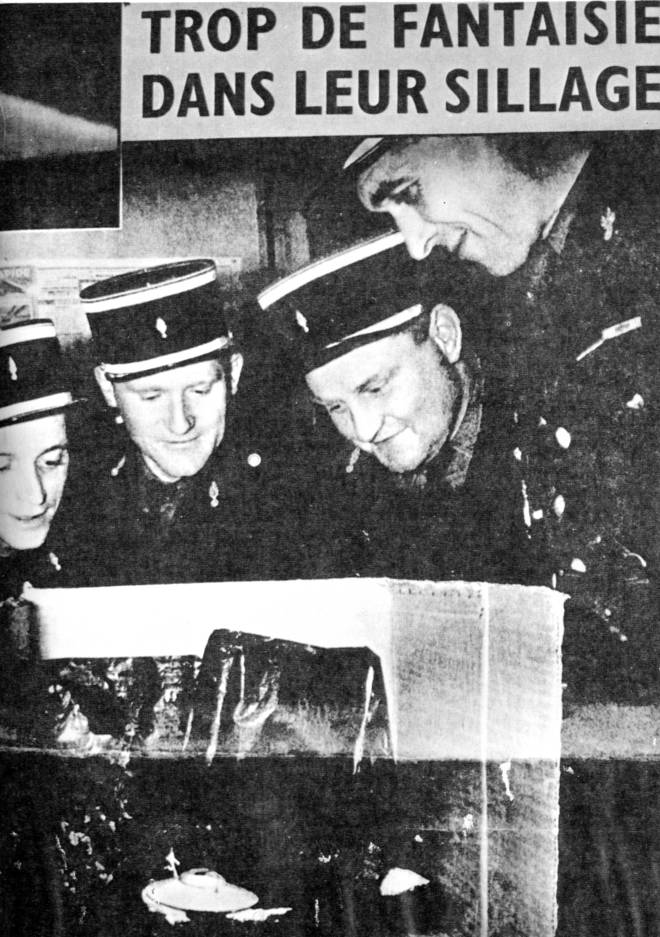
|
What the magazine Radar also tells is a different version of the farce; which was said to have been told to them by Jean Gérault:
Jean Gérault, apprentice photographer, had just developed these photos from a film deposited by Mr. Halb with his boss. Gérault "wanted to laugh" and then ran to the newspaper L'Est Républicain where he played his role of witness so well that he convinced the most skeptics. He became "the glory of Sarreguemines for 24 hours."
But Mr. Halb saw the photos and the article in the newspaper and immediately informed the newspaper about their true nature.
Just before or shortly after or at the same time, Jean Gérault had been brought to the place of his alleged encounter, and lied "with serenity." But the appearance of the gendarmes gave him "shivers" and in front of them he finally admitted his lies.
[Ref. ler1:] NEWSPAPER "L'EST REPUBLICAIN":

|
If every day brings dozens of testimonies of the existence of flying saucers, it must be admitted that nothing tangible had hitherto furnished a more concrete proof of their presence.
The few photographic documents that we owned were far too nebulous, too much imperfect, if not questionable, to give a real idea of the conformation of the mysterious gear. That is why we do not think we exaggerate by claiming that the narrative below and the three shots of a saucer that we present opposite, constitute, especially in the photographic level, the most important documents in the world, now part of the huge file of the "saucers".
This narrative and these sensational views, we owe them to a young photographer of the Lorraine, Jean Gérault, aged 23 years.
He did not suspect that he was preparing to live, in the North of the Lorraine, the most moving minutes of his life.
It was Saturday, October 23, that destiny was going to put Jean Gérault in the presence of a flying saucer.
That day, around 8:15 p.m., as he does every Thursday and every Saturday, Jean was walking in front of the Cinema Eden, in the center of Sarreguemines. He was waiting for two comrades with whom he had
Continued p. 5.

|
Continued from the first page
agreed to go and spend the evening.
Tired of waiting, he set out on foot in the darkness of October, under the cloudy sky, towards Welferding. A disappointment awaited him. There was indeed a party, but at Ippling, beyond Welferding. Jean Gérault realized that he just had to go back to his lodger, Mr. Léon Bour, 20 rue Alexandre Geiger.
Exceeding the last houses of the locality, on the road to Forbach, in the direction of Saint-Avold took a few more steps.
And he was about to return when, in the distance, on the road, it seemed to him, Jean saw a bright orange hue, which intrigued him. It was as if a parked vehicle was calling for attention by leaving a single powerful headlight on.
"People may have started a fire," he thought. Moving on the road that crosses a basin in these places, Jean Gérault walked towards the light. He was perhaps at one kilometer away. He was still two or three hundred yards away from it when he had a stroke of the body. He had just realized that the luminous focus emanated not from the unusual beacon of a vehicle, but from a dome of which he already clearly guessed the outlines, and that irradiated a mass that the dome dominated with metallic reflections. He observed at the same moment that the unknown device Was not on the road, but a little apart, in the neighboring meadows.
Instinctively, he looked around him. But no one stirred in the dim light.
Then he ventured, flowing from tree to tree, along the road, driven by a curiosity which, in him, disputed with terror.
He now saw the saucer very well. For it was a saucer, of the most calssical shape, that which is compared a little to a hollow plate turned over.
Thus, the heart beating and the breath short, half crawling in the ditch that borders the road, standing up behind each tree, he succeeded in concealing himself behind a trunk, at about a dozen meters from the craft.
The latter stood motionless, one meter or one meter fifty in height, above the neighboring meadow. It was not posed on anything, but emitted a slight purr, like that of an electric motor in operation.
The lower part, with metal polish, was limited, on the outside, by a kind of quite thin strip, metallic too, at least in appearance.
The upper part was a semi-cylindrical cupola made of a material similar to frosted glass.
A strong antenna, fixed to the lower part, stood quite clearly above the whole. The entire interior of the dome was illuminated, and in some places the rays marked the "frosted glass" areas, as if several light sources had projected their beams from the inside to the outside. Because of the consistency of what was inside.
In the pocket of his gabardine there was a small camera. Trembling as he was, Jean Gérault did not want to miss the exceptional opportunity offered to him. "Twelve meters from the saucer, trembling from head to foot, I took like this two pictures... And then the camera fell from my hands. I bent down to pick it up, I took two other shots still, always in pose, and then, without asking for more, bent as much as I could in the ditch, I fled back to sixty meters of the craft."
"I do not know why, but it was from that moment that I realized even more the fear that was in me."
"Behind another tree, I then looked at the saucer a little better than I had done when I was photographing it." It is in these terms that Jean Gérault tells us the most dramatic episode that he lived on this Saturday evening.
A minute perhaps after his return, without anything special, except that the intensity of its light had announced its departure, Jean suddenly saw the saucer rise obliquely towards the sky, pass very quickly over the neighboring groves, and disappear, far before him in the low clouds.
Still shaken by chills, wondering if he had really dreamed, the young man went back to Welferding and Sarreguemines. The road was deserted. No other witnesses had attended the phenomenon.
"I went for a glass of white wine in a cafe, to recover a bit of my emotions. Then I went back to bed. It could have been midnight and a half. A comrade who lives with me, besides, saw me arrive.
"I revealed nothing that happened to my comrade and nothing to the others of my entourage. I was afraid that I would not be taken seriously. And since I had to go to Vézelise the following Saturday, I thought it was better to wait for my father to develop my film." In the days that followed, Jean received no news suggesting that there had been other witnesses of the passage of the saucer. From Welferding, it is true, one can scarcely see what is happening in the bowl where the craft landed.
Saturday, October 30, evening, in their laboratory, Mr. Henri Gérault and his son worked until midnight to the development of the film and the printing of the photographs came yesterday. They were coming back from Stenay.
And it is in the offices of our central editorial office in Nancy that Jean Gérault, a young man of sympathetic and serious looks told us the unordinary story that we just delivered to our readers.
It is not for us to judge. We have just given the fact with objectivity which, without doubt, will motivate an investigation. This investigation will be followed and we will give conclusions to Mr. Gérault, it is certain that we are divided, throughout his narrative, between skepticism, doubt, and astonishment.
Lieutenant-Colonel Leroy, vice-president of the Aero Club de l'Est, to whom we submitted yesterday evening, the documents we published on the front page told us:
"The documents I have just been submitted to are impressive." I had known until now of only one serious photographic document: one that was taken in the United States, already a few years ago. It was an overall photograph of a craft in the air. At the sight of the American document one evokes the possibility of luminous phenomena due to the lens systems, encountered often in the sky. Whereas the photo presented here has many material aspects more precise and more concrete. We remain perplexed in front of the photos that one just put under my eyes, whose details can hardly be the effects of optical illusions. If it is a trick, this trick, in itself, already, would be a tour de force.
[Ref. aue1:] NEWSPAPER "L'AURORE:

|
NANCY (by telephone). -- A young photographer, Jean Géraut, 23 years old, currently working for Mr. Meyer in Sarreguemines (Moselle), came face to face, a few nights ago, with a flying saucer at Welferding, a village located two kilometers from Sarreguemines.
Having his camera in his pocket, he managed to approach within about twelve meters of the craft, whose top was lit by a rather intense yellowish-red light, and succeeded in taking three photographs.
[Ref. ler2:] NEWSPAPER "L'EST REPUBLICAIN":

|
[Photo caption:] This miniature world, being examined by the gendarmes of SARREGUEMINES, holds the key to many mysteries, many "sightings," and certain "interplanetary" hoaxes.
In yesterday's edition, by publishing on the front page of our newspaper the photographs that Jean Gérault claimed to have taken of a flying saucer from a distance of 12 meters from its landing site, we announced-while surrounding the photographer's revelations with the necessary caution-that we would not fail to keep our readers informed about the investigation that was sure to follow.
Alongside the investigation that the authorities would inevitably open, we intended to conduct our own inquiry into Jean Gérault's claims.
The results of this investigation came quickly. Shortly after noon, we were informed by our correspondent in Sarreguemines of the statements made to him by a young student from the town, Mr. Jacques Halb, who had just read our paper from the day before.
Mr. Halb informed our correspondent that he was the true author of the photographic montage, which he had created for fun to play a prank on his friends. He accused Jean Gérault of having stolen the montage in order to gain the benefits that one can imagine.
We publish further below, in detail, the statements of the student, Mr. Jacques Halb.
Yesterday, already, we wrote in the commentary accompanying the photos: "If there was fakery, this fakery itself is a feat."
Indeed, one must acknowledge the skill with which Mr. Halb created his little game-innocent in his intent, since he was unaware of how the young photographer Jean Gérault would exploit it.
As for us, by bringing to public attention the documents presented by Jean Gérault and the statements he made in our office during an interrogation, we believe we fulfilled our duty as journalists. Nevertheless, we made the natural reservations that are required in matters such as the story of flying saucers-where mystery, contradictions, fantasy, and the bizarre are interwoven with testimonies that are often sincere and frequently unsettling.
Before allowing ourselves to be even halfway convinced, we had, in particular, repeatedly drawn young Gérault's attention-in the presence of his father and godfather-both reasonable men with excellent reputations-to the importance of his statements and the serious consequences that would result for him in any case. We questioned him for more than two hours, having him return several times
Continued on page 7
[Photo caption:] Jean GERAULT, the inventor of the Sarreguemines flying saucer, claimed that the craft he saw at the roadside on the night of Saturday the 23rd was at least 5 meters in diameter. The object in the gendarme's hand has now taken on more realistic proportions.
(Photos Lorrain.)

|
[Photo caption:] "You see," Mr. GERAULT Sr. told us a few moments after his son's return (our photo), "you never really know your children." (Photo Hugy.)
(Continued from the front page)
...revisited certain details of the circumstances of its discovery, without detecting any significant variations or omissions in his account. The family's history of honesty, the credibility attached to the name and presence of his father, the apparent sincerity and firmness of Jean Gérault's statements, and finally, the photographic quality of those soft documents, all seemed to significantly reduce the margin for professional skepticism and made it impossible for us to remain indifferent.
Moreover, the explanation - which you will read further on - of the mechanism of the trick, which Mr. Gérault turned into a deliberate deception, shows that it was practically impossible to uncover. The creator of the montage and its user were, in fact, two different people who did not know each other and had no connection or common ground, except for both having an irreproachable reputation.
Why did Jean Gérault commit this hoax? Completely devastated, he was unable to offer any acceptable explanation.
Once caught in the gears of his lie, he lacked the courage to extricate himself, to the point that, when taken to the scene yesterday morning by two of our reporters, he precisely and calmly indicated the spot "where," he said, "he had seen the saucer."
Ambition? A desire for publicity? The wish, shared by so many young people today, to carve out a role beyond their measure? We will probably never know. No matter...
In conclusion to our article yesterday, did we not write: "In the meantime, there will remain, in many minds-and in ours as well-a question mark regarding the nature, the origin, and even the reality of flying saucers, to which the documents and the story we publish today provide no decisive answer."
SARREGUEMINES (from our special correspondent):
Jean Gérault appeared very at ease during the whole trip, chatting with us and showing great good humor. Upon reaching the bend before Welderding, about one kilometer from the village, he signaled for us to stop. It was around noon.
Gérault walked directly to a tree on the right side of the Welferding road and pointed out a spot about twelve meters away, on the other side of the path, where he claimed to have seen the object. Upon inspection, this location did not hold up: the foreground visible in the photo was absent from the actual terrain, and the slope of the ground would have required the saucer to be far above him. He would have had to adopt an acrobatic and unlikely position to take a series of photographs.
However, twenty meters farther on, the landscape matched the photo much better. Gérault, still very relaxed, simply said: "Strange, I don't remember it being so close to the bend. And I thought the tree I was leaning on was bigger."
But one could imagine the presence of a craft in the field before us: an open, fairly flat field, a rise in the terrain roughly matching the ground shown in the photo, shrubs resembling those depicted, etc.
Of course, none of this was conclusive, but there were no glaring inconsistencies either. Not far from there were some small farms. The residents, when questioned, had seen nothing: it was 11:30 p.m. and they were already in bed. Again, nothing could be proven either way. Additionally, there were no traces in the grass.
It was then 1:30 p.m. Gérault went so far as to recommend a restaurant. On the way, the young man's landlord, Mr. Léon Bour, was among the crowd of excited Sarreguemines residents. He struck up a conversation: "He's a very serious young man," he told us, "I've known him for eight months, I vouch for him."
Meanwhile, Gérault was telling Mr. Bour, looking quite proud of himself and still unflinching: "Now you understand why I kept quiet for eight days!..."
Then he confidently walked into the restaurant. He had barely taken a seat when gendarme Tritz entered the room, sent by his brigade chief. Mr. Meyer, the young photographer's employer, was with him. "Get up," said the officer, "and come with me, I have to question you."
The young man initially reacted arrogantly, but within moments, his bravado crumbled. The gendarme had already begun his investigation and knew enough to throw Gérault off balance. Nervously overwhelmed, Gérault suddenly fainted.
Revived and taken into a small room, he began to confess. Here's what happened: it was a clever montage patiently created in his spare time by an amateur engineer-photographer and photographed by him "to fool his friends." The photographic document had been taken to Mr. Meyer's shop. Gérault, in charge of developing, noticed the film and simply stole it.
The whole affair began on a Sunday, October 24, the day after Gérault claimed to have "seen" the saucer.
A young man from Sarreguemines, Mr. Jacques Halb, age 17, a student in Metz and son of a well-known former magistrate, had gone to the cinema. He noticed an advertisement from "La Pie qui chante." It read roughly: "We offer one kilo of our candies to anyone who can bring us a photo of flying saucers."
Was Jacques Halb tempted by this enticing offer? In any case, the next day he decided, for fun of course, to execute the idea.
Nothing could be simpler for this clever and creative mind. The day before, his parents had collected moss from the fields for their turtle. This moss became the ideal landscape. A few crushed brick pieces, the size of fingernails, formed the ground's texture. The saucer was simply a 12-centimeter stove ring; the upper dome was a light bulb sawed in half, the body molded in clay on the ring. The antenna was a mere copper wire, five centimeters high, planted into the clay. The saucer was built.
All that remained was to set the scene: a cardboard box with one side removed served as a frame. In the background, carbon paper simulated a pitch-black night. Three converging lights illuminated the setup: two 40-watt bulbs and one 60-watt bulb. A bit of cigarette smoke gave the illusion of blur and infinity. Everything was ready for the photo.
Mr. Halb used a Kodak 6x9 camera. He positioned it 13 centimeters from the miniature scene, adding a magnifying lens to the objective. He darkened the room and triggered the shutter. He took four shots in quick succession. The trick was done.
He had spent three hours building the setup. Four minutes were enough to take the photographs. All that remained was to develop them.
The next day, Tuesday, he went to Mr. Meyer's shop, where he was received by the latter's wife. He handed over his film and thought no more of it.
The film passed into the hands of Jean Gérault.
According to him, he developed the film that same evening. What went through his mind? He remembered a film he had seen a few days earlier that had left a strong impression: *The War of the Worlds*. He heard about flying saucers daily. Maybe he wanted to create a persona, to boost his prestige among his peers? In any case, it's clear he had no idea how big this story could become.
Whatever the case, he had no qualms. He pocketed the film, developed it, found it intriguing and... kept it. The next day, the rightful owner was to come retrieve his negatives. Nothing was easier. Gérault collected seven blank negatives, placed them in a bag, added one real but underexposed and unreadable negative, and had Mrs. Meyer give them to the client.
The sleight of hand was clumsy: Gérault had chosen various bits of film that were easily identifiable to any photography enthusiast and of different colors. But the student, told the photos were ruined, didn't look too closely.
Thus, Gérault had the original negative. He waited a week and, upon returning to Vézelise for All Saints' Day, he produced the print and showed it to his father.
The latter, in good faith, got excited about his son's "discovery" and, on Monday evening, brought Jean Gérault, along with his godfather, to Nancy to make the declarations we know about.
On Tuesday morning, upon seeing the newspaper that everyone in Sarreguemines was talking about, Jacques Halb exclaimed: "But those are my photos!"
He alerted our correspondent and the gendarmerie, and Gérault was received in Sarreguemines in the manner we've described.
The people of Sarreguemines, who at 1 p.m. had welcomed the young man as a hero and had crowded around him to hear his story a hundred times, now rightly viewed him as a thoughtless and unscrupulous fool.
And Gérault, on his way back, anxiously awaited the moment he would have to face his father.
Let us leave him to these confrontations and hope that the extravagant adventure he threw himself into will at least help temper, for a time, the extraordinary psychosis surrounding flying saucers.
[Ref. bre1:] NEWSPAPER "LA BOURGOGNE REPUBLICAINE":
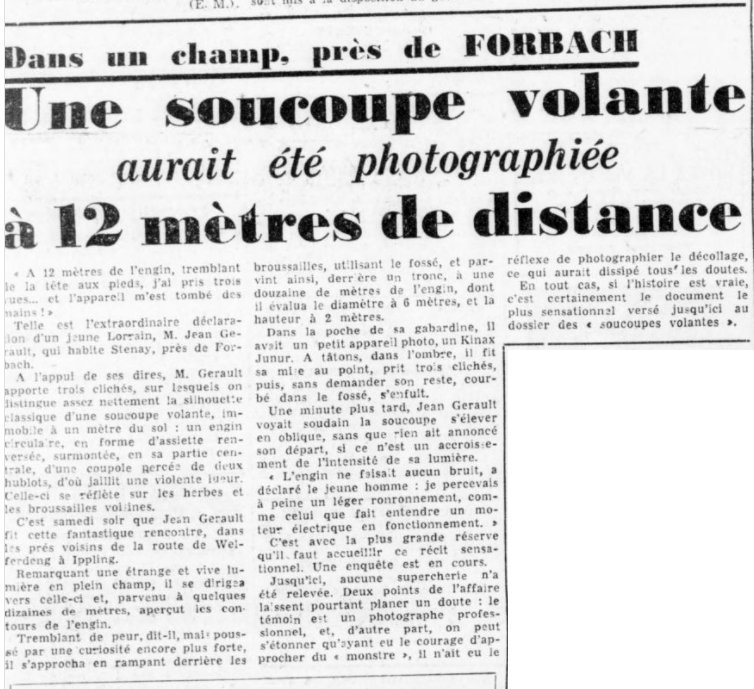
|
"At 12 meters of the craft, shaking from head to toe, I took three photos... and the camera fell from the hands!"
This is the extraordinary statement of a young man from Lorraine, Mr. Jean Gerault, who lives in Stenay, near Forbach.
In support of his statements, Mr. Gerault brings three pictures, on which we can quite clearly distinguish the classic silhouette of a flying saucer, motionless one meter above the ground: a circular craft, in the form of an inverted plate, surmounted, in its central part, by a dome pierced by two portholes, from which a violent glow emerges.
This reflects off the nearby grasses and brush.
It was Saturday evening that Jean Gerault made this fantastic encounter, in the meadows near the road from Welferding to Ippling.
Noticing a strange and bright light in the field, he walked towards it, and reaching a few tens of meters, saw the contours of the craft.
Trembling with fear, he said, but impelled by an even stronger curiosity, he crept up behind the brush, using the ditch, and thus came, behind a log, a dozen meters from the craft, whose diameter he estimated at 6 meters, and the height at 2 meters.
In the pocket of his gabardine, he had a small camera, a Kinax Junur. Groping, in the shadows, he focused, took three pictures, then, without asking for more, bent in the ditch, fled.
A minute later, Jean Gérault suddenly saw the saucer rise obliquely, without anything announcing its departure, except an increase in the intensity of its light.
"The craft made no noise," the young man said, "I could hardly hear a slight hum, like that made by an electric motor in operation."
It is with the greatest caution that this sensational story should be received. An investigation is underway.
So far, no deception has been detected. However, two aspects of the affair leave room for doubt: the witness is a professional photographer, and, on the other hand, it is surprising that having had the courage to approach the "monster" he did not have the reflex to photograph the takeoff, which would have dispelled all doubts.
In any case, if the story is true, this is certainly the most sensational document to date in the "flying saucers" file.
[Ref. dna1:] "DERNIERES NOUVELLES D'ALSACE" NEWSPAPER:
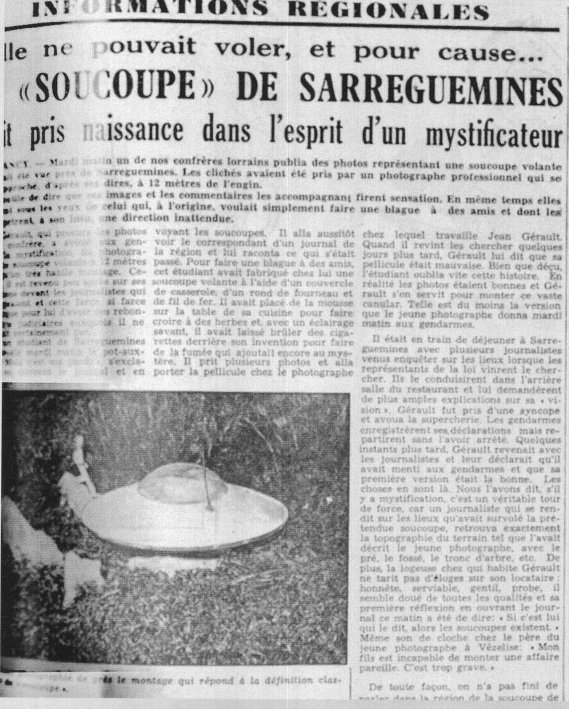
|
NANCY. -- Tuesday morning, one of our Lorraine fellow newspaper published photographs representing a flying saucer reportedly seen close to Sarreguemines. The photographs were taken by a professional photographer who approached, according to his statements, within 12 meters of the craft.
Needless to say that these images and the accompanying comments caused a sensation. At the same time they [] under the eyes ones of the one who, in the beginning, just wanted to play a prank to friends and are the [] took without his knowledge an unexpected turn.
[], [], who gave the photographs [] his brother, acknowledged mystification to the gendarmes. His photography of a flying saucer at 12 meters, is only a skillful assembly. This [] changed his statements soon afterwards in front of the journalists who [], and this prank, if it is a prank, [] to have legal consequences for him which he certainly did not expect.
A student of Sarreguemines revealed Tuesday morning the truth [] exclaimed [] the newspaper and by seeing the saucers. He went at once to meet the correspondent of a newspaper of the area and told him what had occurred. To play a prank on friends, this student had manufactured at home a flying saucer using a pan lid, an oven round and wire. He had placed moss on the table of his kitchen to make believe in grasses and, with clever lighting, he had let cigarettes burn behind his invention to produce smoke which further added to the mystery. He took several photographs and went to bring the film to a laboratory where [] worked. When he came back [] days later, Gérault [] film was bad [] the student soon forgot [] the photographs [] [] made use of it for [] hoax. Such is [] that the young photographer [] morning to the gendarmes.
He was [] Sarreguemines with sev[] came to investigate on [] representatives of the [] severe. They lead him to [] restaurant room [] more explana[]. [], Gérault was [] and admitted the hoax [] recorded his statements [] went without [] him. Moments later, Gérault [] the journalists and had lied to the gendarmes [] first version [] that's how far things are. [] hoax, it'[] cleverly done, because a journalist went to the spot that[] []ged saucer, n[] the topography of the t[] [] described by the young [] meadow, the ditch, the hol[] [] moreover, the owner at [] is adamant that [] honest, helpful, [] seems to have all his [] [] first thought [] newspaper this morning was to [] [] who says this, so the [] Same story [] young photographer [] his son is unable to [] like that It is too []
In any event, there will be more talk in the area on the saucer of []
[Ref. fso1:] NEWSPAPER "FRANCE SOIR":

|
NANCY, November 2 (report from "France-Soir").
A young man from Lorraine, a professional photographer, Mr. Jean Gérault, twenty-three years old, residing in Sarreguemines, claims to have seen, near this town, between Forbach and Saint-Avold, a flying saucer, of which he took four photographs that were handed over to a newspaper in Nancy.
It was at night that Mr. Jean Gérault, who completed his military service as a certified aviation photographer at Base 135 in Cognac (Charente), reportedly saw a craft hovering motionless above a meadow, 1.50 meters from the ground. From the mysterious craft, topped with a dome, emanated an orange glow, according to the young man. Mr. Jean Gérault had just taken his fourth photo when the saucer ascended diagonally and disappeared. This occurred last Saturday. However, the photographer was not in a hurry to make his astonishing adventure public - which may seem surprising - as he waited until the All Saints' Day holidays to develop his film in his father's laboratory, his father also being a photographer in Vézelise (Meurthe-et-Moselle).
[Ref. fso2:] NEWSPAPER "FRANCE SOIR":

|
Yesterday morning, a provincial newspaper presented to its readers, with all due caution, three photos of a "flying saucer" taken near Sarreguemines during the night. The documents, quite convincing, showed the craft one meter above the ground emitting a strong light. But this saucer was fake, and the publication of the photos was due to a dishonest act. Here is the story. A student from Sarreguemines, wanting to play a prank on his classmates, built a fake saucer using a stove lid, some putty, and half a light bulb. With three light bulbs, he brightly lit his "saucer" and photographed it after placing it on a brick, then in a box containing some strands of seaweed. He brought his film to be developed at a local photographer's shop. One of the employees, Jean Gérault, saw the saucer on the negative, told the student his photos were ruined, and went on to offer the documents to the newspaper. Yesterday, the student was stunned to discover his photos in the paper. He alerted the police, and soon Gérault, after a lengthy interrogation, admitted his dishonesty. On the right, one of the three published photos and (below) a close-up of the "object." The object fit in the palm of a hand. Let's be cautious about the many reported saucer sightings. Gérault had hoped (naively!) that this affair would improve his situation. To that end, he did not hesitate to take advantage of the good faith of several people.
[Ref. ppe1:] NEWSPAPER "PARIS-PRESSE":
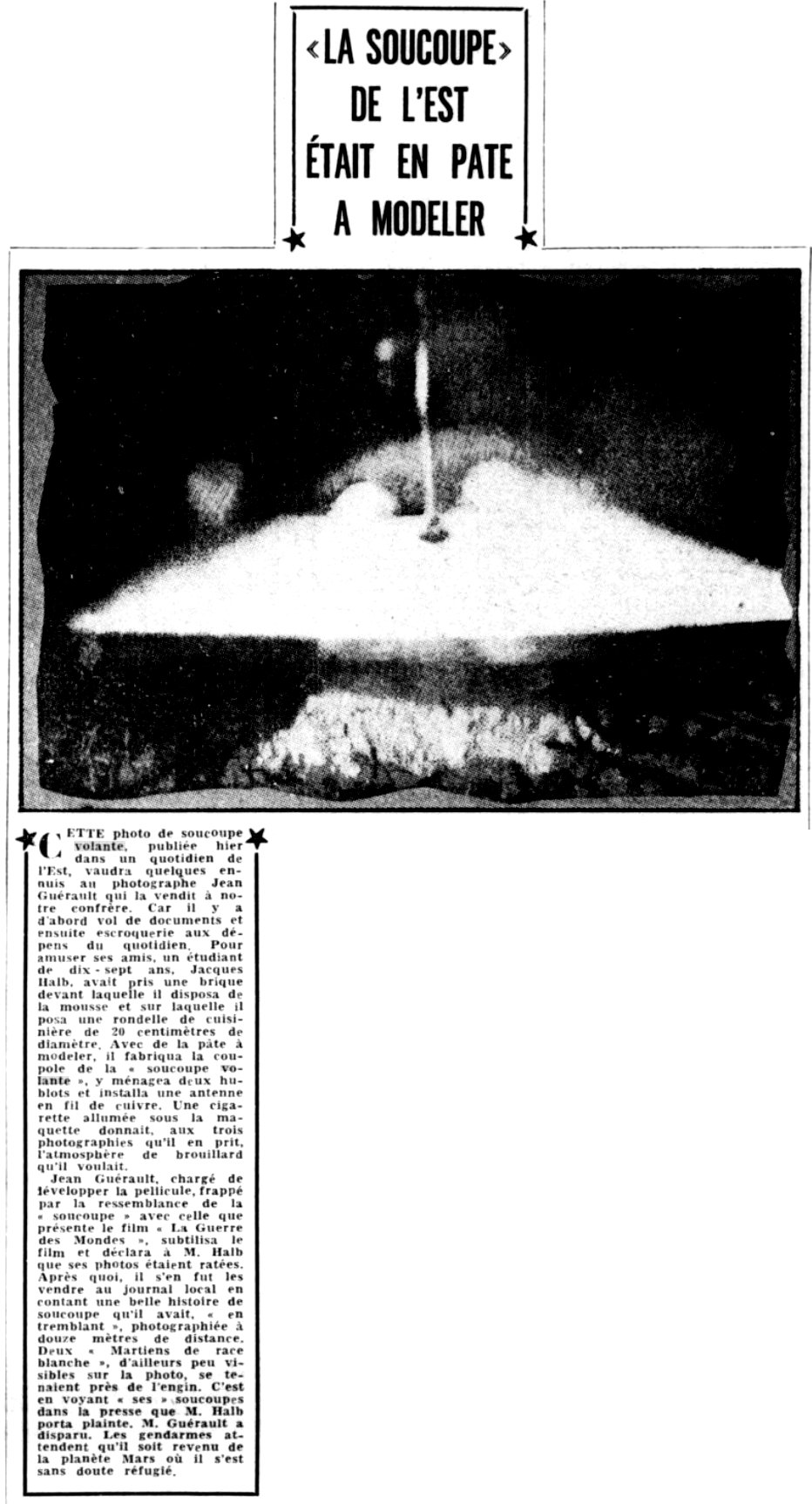
|
THIS photo of a flying saucer, published yesterday in an Eastern daily, will be worth some trouble to photographer Jean Gérault who sold it to our colleague. Because there is first theft of documents and then fraud at the expense of everyday life. To amuse his friends, a seventeen-year-old student, Jacques Halb, had taken a brick in front of which he placed foam and on which he placed a stove washer 20 centimeters in diameter. With plasticine, he made the dome of the "flying saucer", arranged two portholes in it and installed a copper wire antenna. A cigarette lit under the model gave the three photographs he took of it the atmosphere of fog he wanted.
Jean Guérault, in charge of developing the film, struck by the resemblance of the "saucer" with that presented by the movie "The War of the Worlds", stole the film and declared to Mr. Halb that his photos were failed. After which, he went to sell them to the local newspaper, telling a nice story of a saucer that he had, "trembling", photographed from twelve meters away. Two "Caucasian Martians", who were hardly visible in the photo, were standing near the craft. It was when he saw "his" saucers in the press that Mr. Halb complained. Mr. Guérault has disappeared. The gendarmes are waiting for him to return from the planet Mars where he probably took refuge.
[Ref. lcx1:] NEWSPAPER "LA CROIX:
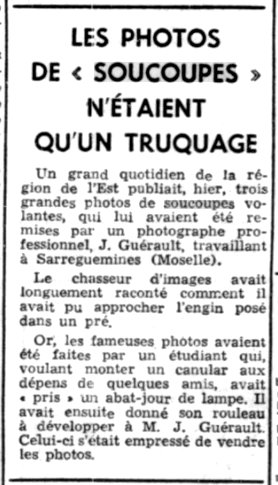
|
A major daily newspaper in the Eastern region published yesterday three large photos of flying saucers, which had been given to them by a professional photographer, J. Guérault, working in Sarreguemines (Moselle).
The image hunter had recounted at length how he had been able to approach the craft posed in a meadow.
However, the famous photos had been taken by a student who, wanting to set up a hoax at the expense of some friends, had "shot" a lamp shade. He then gave his film to develop to Mr. J. Guérault. The latter quickly sold the photos.
[Ref. bre2:] NEWSPAPER "LA BOURGOGNE REPUBLICAINE":
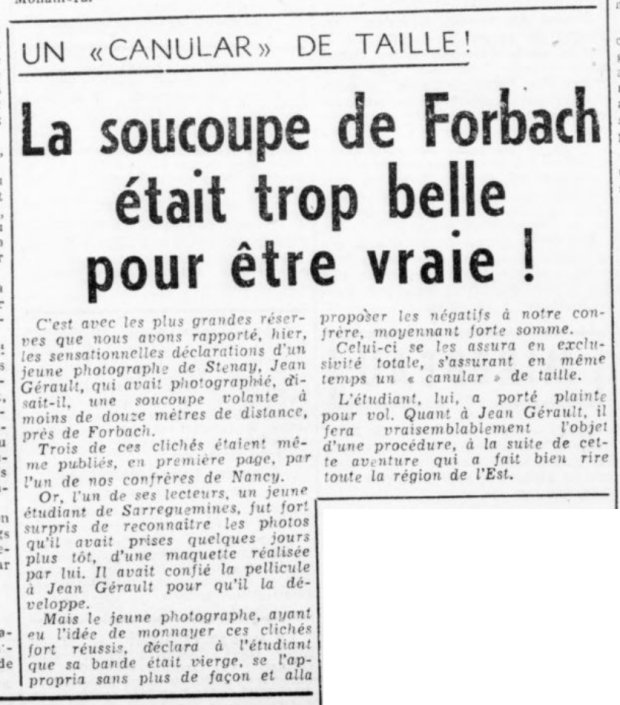
|
It is with the greatest caution that we reported yesterday the sensational statements of a young photographer from Stenay, Jean Gérault, who had photographed, he said, a flying saucer less than 12 meters away, near Forbach.
Three of his photos were even published, on the first page, by one of our colleagues from Nancy.
However, one of their readers, a young student from Sarreguemines, was very surprised to recognize the photos he had taken a few days earlier of a model made by him. He had entrusted the film to Jean Girault to develop it.
But the young photographer, having had the idea of monetizing these very successful pictures, told the student that his film was blank, appropriated it without further ado and went to offer the negatives to our colleague newspaper, against big bucks.
The latter ensured total exclusivity, ensuring at the same time a big "hoax."
The student filed a theft complaint. As for Jean Gérault, he will probably be prosecuted, following this adventure which made the whole Eastern region laugh.
[Ref. csl1:] NEWSPAPER "LE COURRIER DE SAONE-ET-LOIRE":
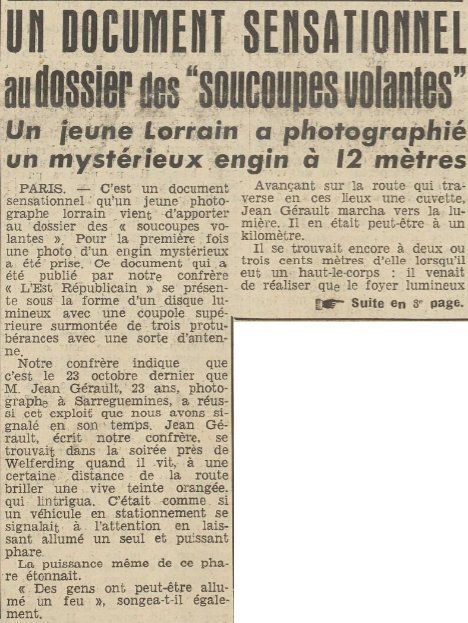
|
PARIS. -- A sensational document has just been added to the flying saucer file by a young photographer from Lorraine. For the first time, a photo of a mysterious craft has been taken. This document, published by our colleague "L'Est Républicain," shows a luminous disc with an upper dome topped by three protrusions and a sort of antenna.
Our colleague reports that it was on October 23 that Mr. Jean Gérault, 23 years old, a photographer in Sarreguemines, achieved this feat, which we reported at the time.
Jean Gérault, writes our colleague, was near Welferding in the evening when he saw, at some distance from the road, a bright orange light that caught his attention. It was as if a parked vehicle was signaling its presence by leaving a single powerful headlight on.
The sheer intensity of the light was astonishing.
"Maybe someone has lit a fire," he also thought.
Moving along the road that at this point crosses a hollow, Jean Gérault walked toward the light. He was perhaps a kilometer away.
He was still two or three hundred meters from it when he suddenly started: he had just realized that the source of the light
Continued on page 8.

|
(Continued from page 1)
was not coming from the unusual headlight of a vehicle, but from a dome whose outlines he could already clearly make out, and from which a mass with metallic reflections, dominated by the dome, was emanating. At the same time, he realized that the unknown craft was not on the road, but slightly off it, in the nearby fields.
Instinctively, he looked all around him. But no one was moving in the shadows.
LIKE AN UPSIDE-DOWN PLATE
Then he ventured forward, slipping from tree to tree along the roadside, driven by a curiosity that competed within him with fear.
He could now see the saucer very clearly. For it was indeed a saucer, of the most classic form, the one often compared to an upside-down soup plate.
Thus, heart pounding and breathing heavily, crawling partly through the ditch along the road, rising behind each tree, he managed to hide behind a trunk, about ten meters from the craft.
The craft hovered motionless, about one to one and a half meters above the neighboring field. It was resting on nothing but emitted a soft humming, like that of an electric motor running.
The lower part, with a polished metallic surface, was bordered externally by a kind of narrow metallic band, at least in appearance.
The upper part was made of a material similar to frosted glass.
A large antenna, attached to the lower part, rose prominently above the whole structure.
The entire interior of the dome was lit, and in places, the beams marked the "frosted glass" with brighter areas, as if several light sources were projecting their beams from inside toward the outside.
Due to the very nature of the dome, Jean Gérault could not distinguish anything inside.
The craft, as a whole, was perhaps five meters in diameter and two meters high.
FOUR SHOTS
In the pocket of his raincoat, he had a small camera. What professional photographer often doesn't carry his work tool with him?
It was a Kinax Junior, with a 6.3 aperture, which he had borrowed from his father while his personal camera, a Welta 6 1/2-11, was being repaired.
A Lumipan 6x9 film was loaded in the Kinax.
Despite shaking all over, Jean Gérault didn't want to miss the exceptional opportunity before him.
As best he could, judging the distance, after making sure once more that no being - human or otherwise - was moving around him, he made an approximate focus of the camera.
Fearing he wouldn't succeed with a snapshot, he braced his hand holding the Kinax against the tree trunk and took a timed exposure lasting about one second.
"At twelve meters from the saucer, shaking from head to toe, I took two shots like that... Then the camera slipped from my hands. I bent down to pick it up and took two more photos, also with timed exposure, and then, not waiting around, crouched as low as I could in the ditch, I fled backwards to about sixty meters from the craft."
OBLIQUE DEPARTURE
"I don't know why, but from that moment I became even more aware of the fear gripping me."
"From behind another tree, I then looked at the saucer a bit better than I had while photographing it."
It's in these words that Jean Gérault tells us about the most dramatic episode he experienced that Saturday evening.
Maybe a minute after he had retreated, without anything particular except an increase in the light's intensity announcing its departure, Jean suddenly saw the saucer rise obliquely into the sky, quickly pass over the nearby groves, and disappear into the low clouds ahead of him.
Our colleague refrains from drawing any conclusions from these facts or the documents he reproduces. But Lieutenant-Colonel Leroy, vice-president of the Aéro-Club of the East, commented:
"The documents just presented to me are impressive. So far, I was only aware of one serious photographic document: the one taken in the United States a few years ago. That was a group photo of craft in the air. Looking at the American document, one could think of lenticular light phenomena, often encountered in the sky. Whereas the photo presented here has much more precise and concrete material aspects. One remains perplexed before the photos that have just been shown to me."
[Ref. fso3:] NEWSPAPER "FRANCE SOIR":

|
METZ, November 4 ("France-Soir" dispatch). -- Photographer Jean Gérault, the flying saucer hoaxer from Sarreguemines, will be prosecuted. This decision was made by the public prosecutor who, although no complaint had been filed, decided to take action against the young man from Lorraine.
[Ref. csl2:] NEWSPAPER "LE COURRIER DE SAONE-ET-LOIRE":
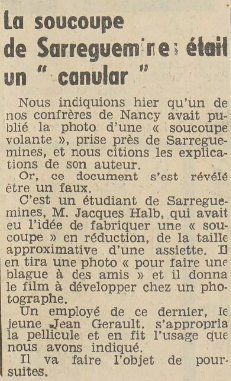
|
We reported yesterday that one of our colleagues in Nancy had published a photo of a "flying saucer" taken near Sarreguemines, and we cited the explanations given by its author.
However, the document turned out to be a fake.
It was a student from Sarreguemines, Mr. Jacques Halb, who had the idea to create a miniature "saucer" about the size of a dinner plate. He took a photo of it "as a prank for his friends" and gave the film to a photographer for development.
An employee at the photo shop, young Jean Gerault, took possession of the film and used it as we described.
He will be subject to legal proceedings.
[Ref. ler3:] NEWSPAPER "L'EST REPUBLICAIN":

|
NANCY. -- Following the publication of a text and photographs related to the story of the "flying saucer" of Welferding, some newspapers in our region have insinuated that "L'Est Républicain" sought to make excessive profits from the use of the documents submitted to it.
In this regard, it is worth considering a letter from Jean Gérault, the central figure in the Welferding affair. Here is the text, dated November 4, 1954:
"I have read the statements attributed to me by a newspaper in Metz in its edition of November 4, 1954.
"I affirm that they do not correspond to reality and, in particular, that I have never said or thought:
"Those who bought it from me sent it to Paris to make excessive profits."
"It is also false to claim that these documents were purchased by the newspaper.
"No transaction had been concluded, and it had simply been agreed that 'L'Est Républicain' would compensate me for this photo if it was proven that it was not a fabrication."
[Ref. rdr1:] "RADAR" MAGAZINE:
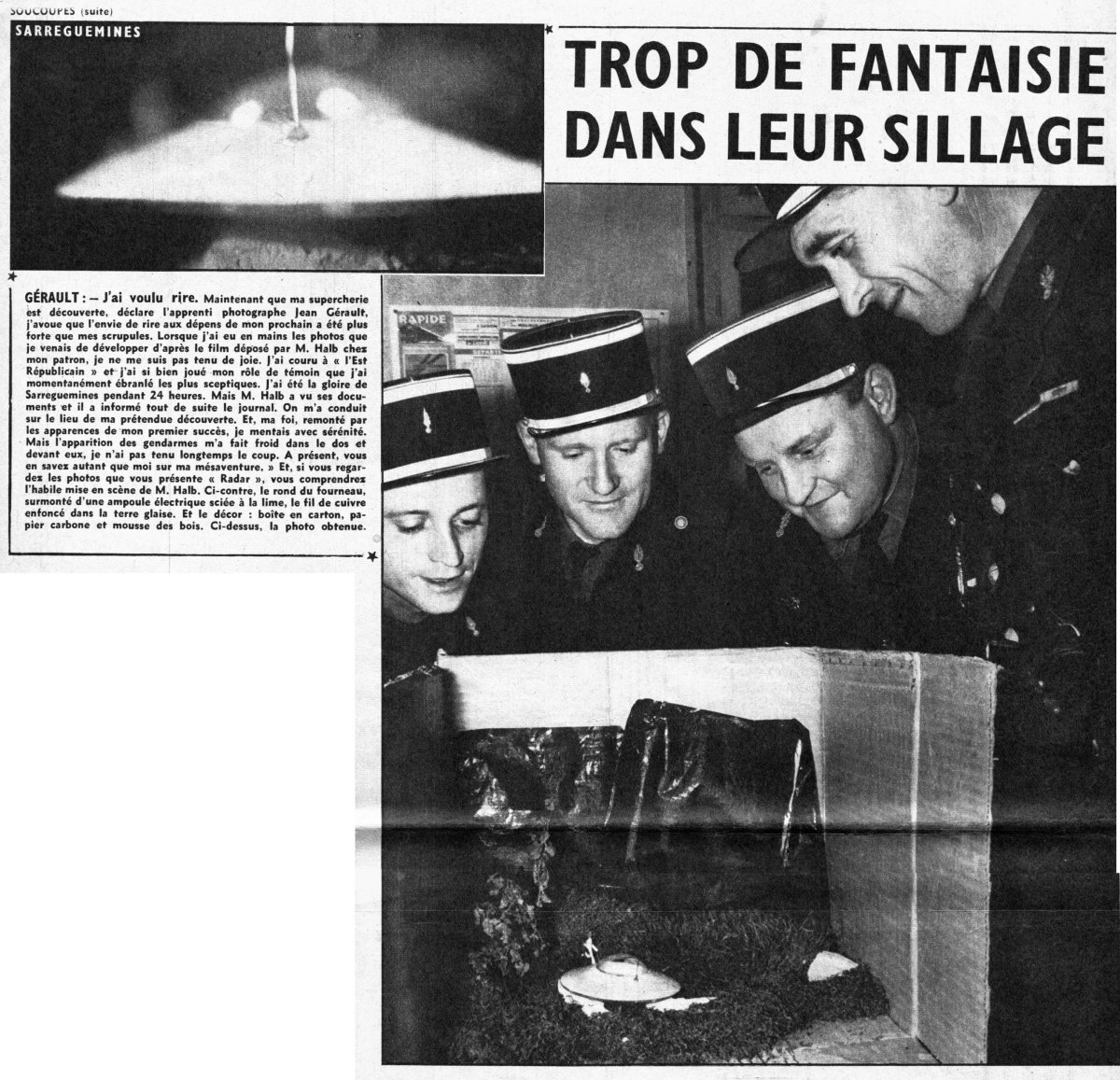
|
GERAULT: - I wanted to laugh. Now that my deception is discovered, says apprentice photographer Jean Gérault, I admit that the urge to laugh at my neighbor's expense has been stronger than my scruples. When I had in hand the photos that I had just developed from the film that Mr. Halb had left with my boss, I did not hold back for joy. I ran to "l'Est Républicain" and played my role of witness so well that I momentarily shook the most skeptical. I was the glory of Sarreguemines for 24 hours. But Mr. Halb saw this document and immediately informed the newspaper. I was taken to the site of my alleged discovery. And, well, encouraged by the appearances of my first success, I lied with serenity. But the involvement of the gendarmes gave me shivers and in front of them I did not last long. By now you know as much as I do about my mishap." And, if you look at the photos "Radar" shows you, you will understand Mr. Halb's skillful staging. Opposite, the round of the furnace, surmounted by an electric bulb sawn with a file, the copper wire buried in the clay. And the setup: cardboard box, carbon paper and wood moss. Above, the resulting photo.
[Ref. rrl1:] ROBERT ROUSSEL:
Robert Roussel indicates that in September 1953, the person in charge of the photo service of a newspaper of the East of France arrived from Nancy in the middle of the night at the Gare de l'Est, sent in all haste by his newspaper's management. He was to convey in the capital a photograph to be negotiated with the most important newspapers, which very distinctly represented a flying saucer and two of its occupants nearby, beings of small size locked up in their diving-suit.
A few hours before at the end of the afternoon, a still trembling young man had rushed in the newsroom of the daily newspaper telling with details its confusing adventure: walking in the countryside, he was suddenly confronted to a strange apparatus in the shape of a saucer and as he had a camera with him he had the reflex to record the fantastic event. The photographer specified that he had then developed his film himself before proposing his extraordinary photograph to the newspaper. He did not want money, he only wanted to be employed at the photo service of the newspaper.
Some members of the editing board had expressed some doubts but a fast study of the negative had however made it possible to think that the photograph was authentic.
As at this time the newspapers literally hustled themselves to offer to their avid readers the increasingly stranger stories of flying saucers, the search for photographic document was in the air and Radar magazine had offered a million francs to the person who could bring such proof, and it was in this context that the editors had decided to publish the photography on first page of their newspaper.
The Parisian newspapers had been very interested by the acquisition of the document, even at a very high price. The next day, the publication on eight columns of this memorable moment caused a true sensation, the newspaper copies sold like madly and, very quickly, during the day, all the copies were bought. The sales of the daily newspaper had never known such a rise since its creation and the concurrent newspapers were frustrated, but not for a long time.
The very same day of the publication of incredible photography, another young man asked to be heard by the chief editor, a student who said that it had an important statement to make about the photography which had been just published. His story was quite different from that which had reported, the day before, the "generous donator". He also was a photo hobbyist and his favorite pastime was to make photographs of models. He remembered to have recently entrusted a roll of film to a professional photographer to have it developed. On this film was, precisely, the image of a model he manufactured of a flying saucer beside which one could see two small beings in diving-suits, and that is the image which did the headline that day.
Robert Roussel says that this was the first case of hoaxed photography in the histoiry of the UFOs, and the deal with the Parisian newspapers did not take place.
[Ref. bbr1:] GERARD BARTHEL AND JACQUES BRUCKER:
The two authors start by quoting an article published by the newspaper "L'Aurore", for November 2, 1954:
"A young photographer, Jean Gerault, aged 23, working at Mr. Meyer's in Sarreguemines (the Moselle), found himself acing a fying saucer in Welferding, a locality 2 kilometers of Sarreguemines."
"Having his camera in his pocket, he managed to approach a dozen meters of the machine, whose top was illuminated by a rather intense reddish light, and succeeded in taking three photographs."
They then induge in irony, with "finally an irrefutable proof", and tell that they made all possible efforts to find "the photograph of this spacecraft of another world."
They then indicate that to have discovered that the saucer had consisted of an electric bulb cut out and stuck on a piece of furnace with an antenna made up of a copper wire planted in loam. They add that the "receipt" for such a saucer had been published by "Radar" magazine for October 14, 1954.
This is followed of a paragraph which tells that they have "the proof now" that "if flying saucers exist" it is "only in the spirit of those who wish they do."
[Ref. lae1:] NEWSPAPER "L'ALSACE":
The regional daily newspaper, in a retrospective of 2004 bearing over the year 1954 in Alsace, mentions one saucer affair.
The newspaper recalls that on November 2, 1954, the 23 year old photographer Jean Gérault of Sarreguemines contacted the local Press and handed over photographs of a flying saucer which he said to have taken one evening while returning home.
The newspaper specifies that the news caused a commotion, everywhere in Alsace-Lorraine, where it was said that extraterrestrial life does exist. The saucer is as the saucers were always imagined, with the shape of a "reverted plate on four metal feet."
The newspaper adds that an investigation uncovered the forger within 24 hours, and that his saucer was made of modeling clay.
[Ref. jbs1:] VICENTE-JUAN BALLESTER-OLMOS:
(77)
DATE: 1 November 1954 (approximate day)
LOCATION: Welferding, Moselle (France)
FORMAT: Picture
PHOTOGRAPHER: Jean Geraut
EXPLANATION: Fake
REFERENCES: Gérard Barthel and Jacques Brucker, La Grande Peur Martienne (Nouvelles Editions Rationnalistes, Paris, 1979), pages 192-193 and plates. It quotes the original source, the journal L'Aurore, November 2, 1954, and the magazine Radar, November 14, 1954, which reveals the deceit.
REMARKS: Nil
[Ref. ler4:] "L'EST REPUBLICAIN" NEWSPAPER:
At the end of October 1954, from Toul to Sarreguemines, abundant testimonies of UFO sightings multiplied.
October 10, 1954. The day has not yet risen in the region of Toul and a fairly dense fog makes it difficult to see. On his way to his workplace, the Ecrouves penitentiary, a 40-year-old supervisor nevertheless managed to see an aluminum shape at a crossroads in the light projected by the headlight of his motorcycle. For the prison guard, no doubt, this is a "saucer". At least that is what he entrusts to our colleagues. In our October 24 columns, he said: "It was about 2 m in diameter and 1 m 40 in height. It was circular with a dome and pierced on its periphery with two portholes.
Is it an hallucination? Two of his colleagues will confess to having seen this same day, this time around 4 pm, a disc that left behind a glowing trail. Yes Yes! Even better. In Longwy, again and again on October 10, 1954, an observer will claim to have witnessed an identical phenomenon at around 1:30 am where the delirium eventually prevailed is when the supervisor said he did not believe in a Martian explanation but "weapons built by a foreign power" and which would have taken off from "the Antarctic, land of refuge of foreign political and scientific leaders". But of course.
At the same time, testimonies of UFO observation multiplied in Lorraine. One narrative receives particular media attention. That of a young photographer of 23 years of Vézelise. He says he was the first to have photographed a flying saucer. Photographs he unveiled to the press and which he assures to have taken on Saturday 23 October 1954, in the district of Welferding, in Sarreguemines. That evening, he had an appointment with two comrades to go and chew a movie at the communal cinema. Tired of waiting, he decides to go to the Welferding district where, he believes, a party is in full swing.
"Twelve meters from the saucer, trembling from head to foot, I took three views"
Along the way, he sees a bright orange shade in the distance intriguing him, he recounts. Carried by a curiosity which "frightened him," it can be read in the newspapers of the day, he approaches this object which resembled a hollow plate turned upside down. "Twelve meters from the saucer, trembling from head to foot, I took three views," he said. Photographs that he will propose to the newspapers and that will make the buzz of the time. Aviation specialists will be contacted. They will be skeptical, but by the end of 1954, the population is wondering about the existence of an extraterrestrial life, especially since testimonies abound. A few days later, several people will claim to have also seen saucers in Sarreguemines.
The truth broke out very quickly. A student of Sarreguemines will indeed declare to be the author of the photographic montage that the young man of Vézelise used to make the buzz.
However, an investigation was opened by the gendarmes. Harassed by questions, the resident of Meurthe-et-Moselle fainted during his interrogation before confessing. The motive is as funny as it is unlikely. The young student who made the photographic montage had the idea to make a saucer at the end of a cinema show, discovering an advertising poster of the "Pie qui chante". It said: "We offer a kilo of candy to anyone who can bring us a picture of flying saucers"! His friend used it to build up his story from scratch.
Whereas the two young people had a bad time, their abracadabra narrative had the merit of shutting down the extraordinary psychosis around the flying saucers which reigned at the end of 1954 in Lorraine. Since then, the observation evidence of saucers are concentrated in the summer. Often on Saturdays. At the moment when newlyweds let go of luminous balloons [Chinese lanterns] that many perceive as objects from an extraterrestrial life.
Alexandre POPLAVSKY
[Ref. ble1:] "BLL ARCHIVES" WEBSITE:
Comments »0
Spheres, luminous cones or cigars, discharging of batteries, dancing colors, etc., between the 1st and the 21st of October 1954, some twenty testimonies and observations of UFOs (Unidentified Flying Objects) were collected in the Moselle, the more particularly in the communes of Vergaville, Bidestroff, Kerprich, Guébling, Morsbach, Moncourt, Saint-Avold, Saint-Quirin and Jouy-aux-Arches. In Pournoy-la-Chétive, near Metz, two children declared that they had seen an alien with a hairy face come down from his flying saucer to come and speak to them in an incomprehensible language.
[Ref. jbo2:] JUAN-VICENTE BALLESTER OLMOS:
| Date | Approx | UFO | Nation | Photo Film | Media | Duration | Blue Book | |||||||||||
|---|---|---|---|---|---|---|---|---|---|---|---|---|---|---|---|---|---|---|
| 11-01-1954 | D | UNK | Fake (landing) | OK | Welferding, Moselle (France) | FRA | 57 | PHOTO CE | Jean Gerault | Gérard Barthel & Jacques Brucker, La Grande Peur Martienne, Nouvelles Editions Rationalistes, 1979, plates and pp 191-193, quoting L'Aurore, November 2, 1954 and magazine Radar, November 14, 1954. | Published November 2, 1954 |
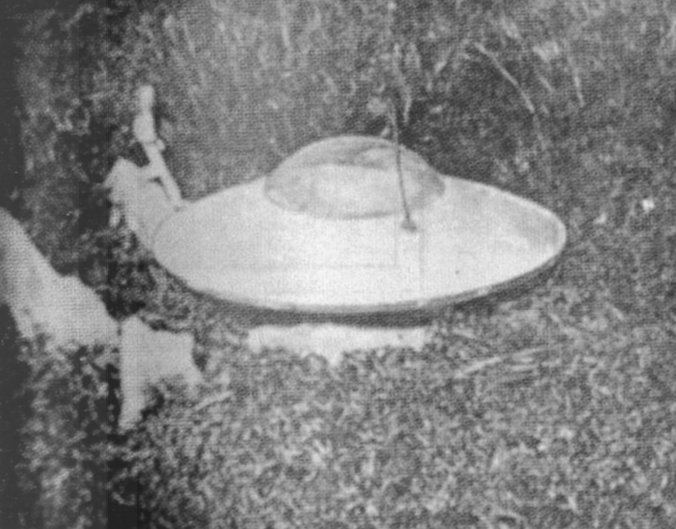
|
Underneath: the hoax exposed by the gendarmes, Radar magazine photograph.

|
Underneath: Radar magazine photograph.
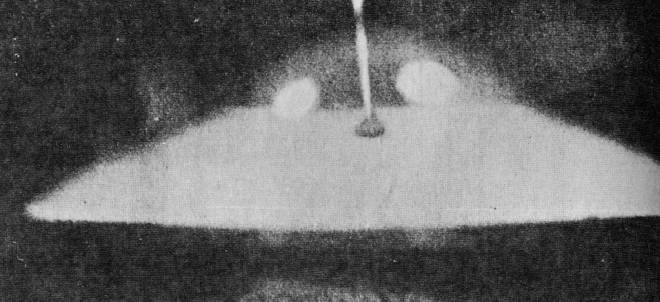
|
Contrarily to what was indicated in certain newspapers, the flying saucer was not in modeling clay. It was the four "Martians" who "came out of it" that were in modeling clay, as one of the photographs reproduced in the Press of that time shows (see above).
Once again, Barthel and Brucker use half-truths in attempt of ridiculisation of the ufologists:
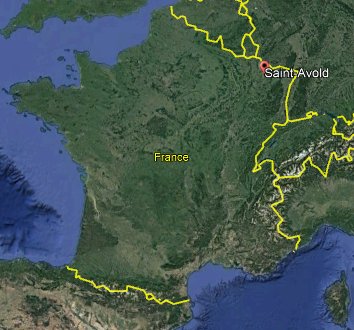
|
Photographic hoax, as per the newspaper Les Dernières Nouvelles d'Alsace for November 3, 1954.
(These keywords are only to help queries and are not implying anything.)
Sarreguemines, Moselle, photograph, picture, hoax, saucer
[----] indicates sources that are not yet available to me.
| Version: | Created/Changed by: | Date: | Change Description: |
|---|---|---|---|
| 0.1 | Patrick Gross | September 30, 2005 | First published. |
| 1.0 | Patrick Gross | December 26, 2008 | Conversion from HTML to XHTML Strict. First formal version. Addition [dna1]. |
| 1.1 | Patrick Gross | January 4, 2009 | Addition [jbs1]. |
| 1.2 | Patrick Gross | April 9, 2010 | Addition [jbs1]. |
| 1.3 | Patrick Gross | November 1, 2011 | A search on the web and in my documentation did not reveal other sources. |
| 1.4 | Patrick Gross | January 6, 2017 | Addition [ler1]. Change of case date from November 2 to October 23. |
| 1.5 | Patrick Gross | January 26, 2017 | Addition [ler4]. Change of case place from Sarrebourg to Saint-Avold. |
| 1.6 | Patrick Gross | February 11, 2017 | Additions [ble1]. |
| 1.7 | Patrick Gross | October 23, 2019 | Addition of the Summary. |
| 1.8 | Patrick Gross | December 21, 2019 | Addition [ppe1]. |
| 1.9 | Patrick Gross | December 29, 2020 | Addition [rdr1]. In the Summary, addition of "What the magazine Radar also tells" and what follows. |
| 2.0 | Patrick Gross | January 7, 2021 | Addition [lcx1]. |
| 2.1 | Patrick Gross | January 31, 2021 | Addition [bre1], [bre2]. |
| 2.2 | Patrick Gross | November 1, 2021 | Addition [jbo2]. |
| 2.3 | Patrick Gross | March 17, 2025 | Addition [ler3]. |
| 2.4 | Patrick Gross | April 14, 2025 | Additions [fso1], [fso2]. |
| 2.5 | Patrick Gross | April 26, 2025 | Addition [csl2]. |
| 2.6 | Patrick Gross | April 29, 2025 | Addition [csl1]. |
| 2.7 | Patrick Gross | June 5, 2025 | Additions [ler2], [fso3]. |
| 2.8 | Patrick Gross | September 14, 2025 | Addition [aue1]. |